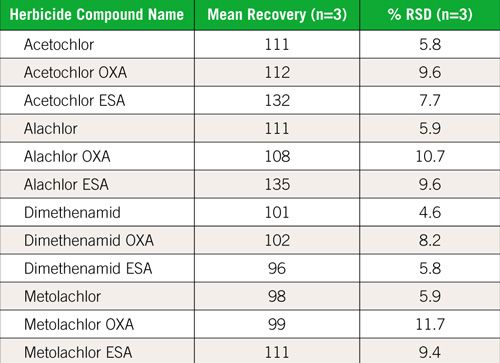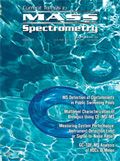Solid-Phase Extraction of US EPA 535 for Chloroacetanilide and Acetamide Degradates in Drinking Water Samples Prior to Liquid Chromatography/Tandem Mass Spectrometry
Special Issues
The US EPA has implemented an exposure research program aimed at conducting drinking water research on methods as part of the Microbiological and Chemical Exposure Assessment. This research is aimed at evaluating the chemical pollutants and their role and levels in which there is an unacceptable risk to either humans or wildlife, as well as evaluating the methodologies currently being used to determine levels of chemical pollutants.
The US EPA has implemented an exposure research program aimed at conducting drinking water research on methods as part of the Microbiological and Chemical Exposure Assessment. This research is aimed at evaluating the chemical pollutants and their role and levels in which there is an unacceptable risk to either humans or wildlife, as well as evaluating the methodologies currently being used to determine levels of chemical pollutants.
Alachlor is listed as a regulated contaminant under the US Safe Drinking Water Act with a maximum contaminant level of 0.002 mg/L. Several of the other analytes listed in the EPA method are on the contaminant list for unregulated contaminant monitoring rule 3 (UCMR-3), and may require monitoring for occurrence determination. In Europe, the regulatory approach is different and individual pesticides cannot be present at greater than 0.1 µg/L or a total of all pesticides cannot exceed 0.5 µg/L. Pesticides are defined in Europe as insecticides, herbicides, fungicides, and related categories.
Enabling automation to perform the tedious manual SPE procedure can increase the efficiency of a laboratory’s work flow and allow other technician activities to be accomplished during the SPE process. In this application note, determination of chloroacetanilide and acetamide degradates was performed using the automated SmartPrep® Extractor SPE cartridge system according to US EPA 535 prior to LC–MS-MS analysis, with the intent to generate results within the acceptance criteria of the EPA 535 method.
Purified laboratory water samples of 250 mL each were spiked at 2.5 ng/mL in triplicate with an herbicide compound mix and the recoveries are shown in the accompanying table.

Solid-phase extraction provided excellent recoveries within the specifications of the EPA 535 method of these more difficult compounds. Automation of the extraction procedure offered reproducible performance with less technician intervention. Analysis of the herbicides using LC–MS-MS indicated that all produced LC–MS-MS results passed the requirements for mean recovery of water samples being 50–150% of the true spiked value of each of the 12 herbicide compounds, as well as passed the requirements for meeting the <20% RSD criteria for the precision criteria of the same water samples. Low detection limits required by the method were met, as shown by the passing recoveries and excellent precision in the table. Blank injections resulted in no quantifiable herbicide compounds to report, with detection levels down to 0.6 ppb.
References
(1) “US EPA Method 535, Measurement of Chloroacetanilide and Other Acetamide Herbicide Degradates in Drinking Water by Solid Phase Extraction and Liquid Chromatography/Tandem Mass Spectrometry (LC–MS-MS),” April 2005.
(2) “Solid Phase Extraction of US EPA 535 for Chloroacetanilide and Acetamide Degradates in Drinking Water Samples Prior to Liquid Chromatography/Tandem Mass Spectrometry,” AN0901407_01, www.horizontechinc.com.

Horizon Technology, Inc.
16 Northwestern Drive, Salem, NH 03079
tel. (603) 893-3663, fax (603) 893-4994
Website: www.horizontechinc.com

High-Speed Laser MS for Precise, Prep-Free Environmental Particle Tracking
April 21st 2025Scientists at Oak Ridge National Laboratory have demonstrated that a fast, laser-based mass spectrometry method—LA-ICP-TOF-MS—can accurately detect and identify airborne environmental particles, including toxic metal particles like ruthenium, without the need for complex sample preparation. The work offers a breakthrough in rapid, high-resolution analysis of environmental pollutants.
Karl Norris: A Pioneer in Optical Measurements and Near-Infrared Spectroscopy, Part II
April 21st 2025In this two-part "Icons of Spectroscopy" column, executive editor Jerome Workman Jr. details how Karl H. Norris has impacted the analysis of food, agricultural products, and pharmaceuticals over six decades. His pioneering work in optical analysis methods including his development and refinement of near-infrared spectroscopy, has transformed analysis technology. In this Part II article of a two-part series, we summarize Norris’ foundational publications in NIR, his patents, achievements, and legacy.
AI-Powered SERS Spectroscopy Breakthrough Boosts Safety of Medicinal Food Products
April 16th 2025A new deep learning-enhanced spectroscopic platform—SERSome—developed by researchers in China and Finland, identifies medicinal and edible homologs (MEHs) with 98% accuracy. This innovation could revolutionize safety and quality control in the growing MEH market.